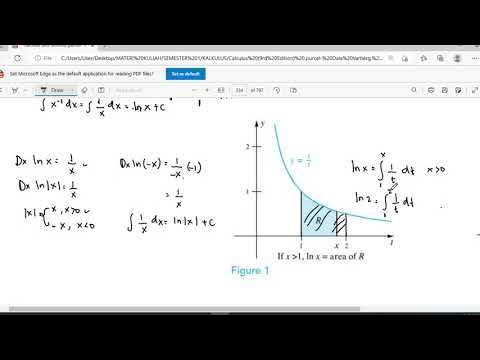Fungsi Logaritma Matematika Peminatan Kelas 10
Summary
TLDRIn this video, Handayani explains the fundamentals of logarithmic functions, covering key concepts such as definitions, examples, and graphing techniques. The tutorial walks viewers through the process of plotting a logarithmic graph by creating a table of values, then plotting those points on a Cartesian plane, and finally connecting them with a smooth curve. It also delves into determining the domain and asymptotes of logarithmic functions, providing practical examples for better understanding. Handayani encourages viewers to practice with exercises to solidify their knowledge of logarithms.
Takeaways
- 😀 The video explains the basics of logarithmic functions and their properties.
- 😀 To understand logarithmic functions, it is essential to master basic concepts and properties of logarithms.
- 😀 A logarithmic function involves a variable (x) in the logarithmic operator, and the basic form is f(x) = log_b(x), where 'b' is the base and 'x' is the argument.
- 😀 Examples of logarithmic functions are given, such as f(x) = log_3(x) and f(x) = log_5(2x + 6).
- 😀 To graph logarithmic functions, three main steps are followed: create a table of values, plot the points on a Cartesian plane, and then connect the points with a smooth curve.
- 😀 When drawing a graph of a logarithmic function, points should be selected such that the x-values are powers of the base for simplicity.
- 😀 The graph should be a smooth curve and should not intersect the y-axis because the y-axis is the asymptote of the graph.
- 😀 To determine the domain of a logarithmic function, we must ensure the argument (numerator) is positive. For example, in the function f(x) = log_6(3x + 9), x must be greater than -3.
- 😀 The video explains how to find the asymptote of a logarithmic function by setting the argument equal to zero and solving for x.
- 😀 An example of finding the asymptote is given with the function f(x) = log_5(2x - 12), where the asymptote occurs at x = 6.
- 😀 Lastly, the video includes exercises to further practice the concepts of logarithmic functions and asymptotes, with solutions provided in a follow-up video.
Q & A
What is a logarithmic function?
-A logarithmic function is a function that involves a variable 'x' inside a logarithmic operator. It typically has the form f(x) = log_b(x), where 'b' is the base and 'x' is the argument, which is a number or an expression that includes 'x'.
What is the basic structure of a logarithmic function?
-The basic structure of a logarithmic function is f(x) = log_b(x), where 'b' is the base of the logarithm and 'x' is the argument. The function involves a variable 'x' inside the logarithmic operation, and the base 'b' can vary, such as in log base 2, log base 5, etc.
How do you graph a logarithmic function?
-To graph a logarithmic function, follow three steps: 1) Create a table with values of x and corresponding values of f(x), 2) Plot these points on a Cartesian plane, and 3) Connect the points with a smooth curve. Ensure the curve approaches but does not touch the y-axis, as it represents an asymptote.
What is an asymptote in a logarithmic function?
-An asymptote in a logarithmic function is a line that the graph approaches but never touches. In the case of logarithmic functions, the y-axis (x = 0) often serves as a vertical asymptote.
How do you find the domain of a logarithmic function?
-The domain of a logarithmic function is determined by the condition that the argument inside the logarithm must be positive. For a function of the form f(x) = log_b(x), x must be greater than 0 for the function to be defined.
What is the condition for the base of a logarithmic function?
-The base 'b' of a logarithmic function must be positive and cannot be equal to 1. The base determines the growth rate of the logarithmic function, but it must be greater than 0 and not equal to 1 for the function to be valid.
How do you determine the domain of a logarithmic function like f(x) = log_6(3x + 9)?
-To determine the domain, you set the expression inside the logarithm (3x + 9) greater than 0, since the argument of the logarithm must be positive. This gives the inequality 3x + 9 > 0, which simplifies to x > -3. Therefore, the domain is x > -3.
What does it mean when the numerator of a logarithmic function is negative?
-If the numerator (the expression inside the logarithm) is negative, the logarithmic function will be undefined, as logarithms of negative numbers are not real-valued in standard real number operations.
What is the general approach to finding asymptotes in logarithmic functions?
-To find the asymptote of a logarithmic function, you set the expression inside the logarithm equal to zero. This is because the logarithmic function will approach negative infinity as the argument approaches zero. The solution to the equation gives the x-value of the asymptote.
How do you find the asymptote for the function f(x) = log_5(2x - 12)?
-To find the asymptote, set the expression inside the logarithm (2x - 12) equal to zero: 2x - 12 = 0. Solving for x gives x = 6, so the asymptote is the vertical line x = 6.
Outlines

This section is available to paid users only. Please upgrade to access this part.
Upgrade NowMindmap

This section is available to paid users only. Please upgrade to access this part.
Upgrade NowKeywords

This section is available to paid users only. Please upgrade to access this part.
Upgrade NowHighlights

This section is available to paid users only. Please upgrade to access this part.
Upgrade NowTranscripts

This section is available to paid users only. Please upgrade to access this part.
Upgrade NowBrowse More Related Video

(Part 1) Fungsi Logaritma Bab Fungsi dan Pemodelannya || Matematika Tingkat Lanjut Kelas XI

Fungsi Eksponensial

(Part 2) Fungsi Logaritma Bab Fungsi dan Pemodelannya || Matematika Tingkat Lanjut Kelas XI

Fungsi Transenden 1 (Logaritma Natural/Ln)

Solving Logarithmic Inequalities | General Mathematics

Matematika Keuangan dan Bisnis - Ep.03 Pengenalan Fungsi
5.0 / 5 (0 votes)